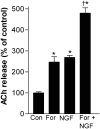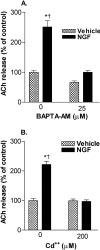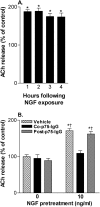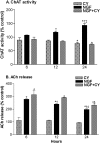Nerve growth factor rapidly induces prolonged acetylcholine release from cultured basal forebrain neurons: differentiation between neuromodulatory and neurotrophic influences
- PMID: 11331367
- PMCID: PMC6762468
- DOI: 10.1523/JNEUROSCI.21-10-03375.2001
Nerve growth factor rapidly induces prolonged acetylcholine release from cultured basal forebrain neurons: differentiation between neuromodulatory and neurotrophic influences
Abstract
Long-term exposure to nerve growth factor (NGF) is well established to have neurotrophic effects on basal forebrain cholinergic neurons, but its potential actions as a fast-acting neuromodulator are not as well understood. We report that NGF (0.1-100 ng/ml) rapidly (<60 min) and robustly enhanced constitutive acetylcholine (ACh) release (148-384% of control) from basal forebrain cultures without immediate persistent increases in choline acetyltransferase activity. More ACh was released in response to NGF when exposure was coupled with a higher depolarization level, suggesting activity dependence. In a long-term potentiation-like manner, brief NGF exposure (10 ng/ml; 60 min) induced robust and prolonged increases in ACh release, a capacity that was shared with the other neurotrophins. K252a (10-100 nm), BAPTA-AM (25 microm), and Cd(2+) (200 microm) prevented NGF enhancement of ACh release, suggesting the involvement of TrkA receptors, Ca(2+), and voltage-gated Ca(2+) channels, respectively. Forskolin (10 microm), a cAMP generator, enhanced constitutive ACh release but did not interact synergistically with NGF. Tetrodotoxin (1 microm) and cycloheximide (2 microm) did not prevent NGF-induced ACh release, indicative of action at the level of the cholinergic nerve terminal and that new protein synthesis is not required for this neurotransmitter-like effect, respectively. In contrast, after a 24 hr NGF treatment, distinct protein synthesis-dependent and independent effects on choline acetyltransferase activity and ACh release were observed. These results indicate that neuromodulator/neurotransmitter-like (protein synthesis-independent) and neurotrophic (translation-dependent) actions likely make distinct contributions to the enhancement of cholinergic activity by NGF.
Figures







Similar articles
-
Neurotrophins differentially enhance acetylcholine release, acetylcholine content and choline acetyltransferase activity in basal forebrain neurons.J Neurochem. 2001 Apr;77(1):253-62. doi: 10.1046/j.1471-4159.2001.t01-1-00234.x. J Neurochem. 2001. PMID: 11279281
-
Differential effects of nerve growth factor on expression of choline acetyltransferase and sodium-coupled choline transport in basal forebrain cholinergic neurons in culture.J Neurochem. 1996 Feb;66(2):804-10. doi: 10.1046/j.1471-4159.1996.66020804.x. J Neurochem. 1996. PMID: 8592155
-
PACAP and NGF cooperatively enhance choline acetyltransferase activity in postnatal basal forebrain neurons by complementary induction of its different mRNA species.Biochem Biophys Res Commun. 2003 Feb 7;301(2):344-9. doi: 10.1016/s0006-291x(02)03037-1. Biochem Biophys Res Commun. 2003. PMID: 12565866
-
Oestrogen and the cholinergic hypothesis: implications for oestrogen replacement therapy in postmenopausal women.Novartis Found Symp. 2000;230:94-107; discussion 107-11. doi: 10.1002/0470870818.ch8. Novartis Found Symp. 2000. PMID: 10965504 Review.
-
NGF-based cholinergic therapies in Alzheimer disease.Handb Clin Neurol. 2025;211:123-135. doi: 10.1016/B978-0-443-19088-9.00007-X. Handb Clin Neurol. 2025. PMID: 40340057 Review.
Cited by
-
Enhanced TrkA signaling impairs basal forebrain-dependent behavior.Front Mol Neurosci. 2023 Sep 22;16:1266983. doi: 10.3389/fnmol.2023.1266983. eCollection 2023. Front Mol Neurosci. 2023. PMID: 37808473 Free PMC article.
-
Acetyl-CoA the key factor for survival or death of cholinergic neurons in course of neurodegenerative diseases.Neurochem Res. 2013 Aug;38(8):1523-42. doi: 10.1007/s11064-013-1060-x. Epub 2013 May 16. Neurochem Res. 2013. PMID: 23677775 Free PMC article. Review.
-
Neurotrophins and target interactions in the development and regulation of sympathetic neuron electrical and synaptic properties.Auton Neurosci. 2009 Nov 17;151(1):46-60. doi: 10.1016/j.autneu.2009.08.009. Epub 2009 Sep 13. Auton Neurosci. 2009. PMID: 19748836 Free PMC article. Review.
-
Deciphering the neuroprotective and neurogenic potential of soluble amyloid precursor protein alpha (sAPPα).Cell Mol Life Sci. 2020 Jun;77(12):2315-2330. doi: 10.1007/s00018-019-03404-x. Epub 2020 Jan 20. Cell Mol Life Sci. 2020. PMID: 31960113 Free PMC article. Review.
-
Protracted effects of chronic oral haloperidol and risperidone on nerve growth factor, cholinergic neurons, and spatial reference learning in rats.Neuroscience. 2007 Dec 5;150(2):413-24. doi: 10.1016/j.neuroscience.2007.09.014. Epub 2007 Sep 14. Neuroscience. 2007. PMID: 17942237 Free PMC article.
References
-
- Albeck DS, Backman C, Veng L, Friden P, Rose GM, Granholm A. Acute application of NGF increases the firing rate of aged rat basal forebrain neurons. Eur J Neurosci. 1999;11:2291–2304. - PubMed
-
- Auld DS, Kar S, Quirion R. Beta-amyloid peptides as direct cholinergic neuromodulators: a missing link? Trends Neurosci. 1998;21:43–49. - PubMed
-
- Auld DS, Day JC, Mennicken F, Quirion R. Pharmacological characterization of endogenous acetylcholine release from primary septal cultures. J Pharmacol Exp Ther. 2000a;292:692–697. - PubMed
-
- Auld DS, Mennicken F, Quirion R. Differentiation between translation-independent neuromodulatory and translation-dependent neurotrophic influences of neurotrophins on basal forebrain cholinergic neurons. Soc Neurosci Abstr. 2000b;26:1869.
-
- Auld DS, Mennicken F, Day JC, Quirion R. Neurotrophins differentially enhance acetylcholine release, acetylcholine content and choline acetyltransferase activity in basal forebrain neurons. J Neurochem. 2001;77:253–262. - PubMed
Publication types
MeSH terms
Substances
LinkOut - more resources
Full Text Sources
Other Literature Sources
Miscellaneous
